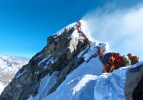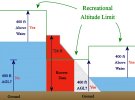It would only be
extremely simple if the rules treated every hazardous obstacle the same way. But it doesn't.
Recreational pilots cannot fly over trees that are taller than 400'. Neither can Part 107 pilots! They're only allowed to fly higher over tall "
structures", and as BigAl07 points out, trees are not structures.
Everyone is allowed to fly 400' higher than any terrain "ground" feature composed of natural earth and rocks, since you're always allowed to fly up to 400' above "ground". So why is ground treated differently than structures? And why aren't trees considered as "ground"? Why do you first need to figure out whether a particular obstacle of earth/rocks is a natural terrain "ground" feature versus a man-made "structure" of earth/rocks? They're each equally obstacles in the way of aviation.
I posted several images a couple of days ago illustrating these questions over in another thread:
mavicpilots.com/threads/why-1400-ft-max-altitude.124266/page-4#post-1408241
I can think of one exception.
What exactly is the "ground" when one refers to AGL? Structures are not ground, and trees are not structures, and trees are also not ground. So trees just don't exist at all, even though they're an obvious hazard to aviation.
So when is "ground" not actually a natural terrain feature composed of earth or rocks (not trees), and definitely never to be confused with un-natural rock/earth man-made "structure"?
The exception is that 400' AGL is not
always measured from solid ground. It's also frequently measured from the top surface of any body of water, rather than from the solid ground at the lake's bottom. Trees are not structures and not ground. Water is not a structure, but it
is ground. Okay.
Here's another example where the 400' AGL,
with no exceptions, for Recreational Pilots is neither
extremely simple nor obvious.
Lets pick an obvious "obstacle" like the Hoover Dam.
NOTE: You're not actually allowed to fly over the Hoover Dam. It's a strict NFZ. Flying a Chinese drone to take surveillance images over such a vulnerable "structure" is a threat to Homeland Security. Of course any tourists, even Chinese tourists, are instead welcome to drive their car along the top of the dam, and stop at the visitor centre to take a tour of the power plant and snap as many photos as they like. You just can't do it using a drone, because... Well, um, just because.
Solely for the purpose of this example, assume that Recreational Pilots
are allowed to fly over the Hoover Dam. Below is a cross sectional diagram. How high would you be allowed to fly here?
The dam itself is 726' high, presumably measured from the "ground" up. So, if you're never allowed to fly higher than 400' above "ground", you'd never be allowed to fly over this dam.
But you're in luck, because apparently one can measure AGL relative to the top of the water's surface, not actually from the "ground". Don't ignore the fact that the water level in this reservoir can fluctuate quite dramatically. But assume that, arriving from upstream at a height not exceeding 400' AGL, you
can clear the top of the dam.
Bit wait! You still cannot cross over the top of the dam! Remember that dam is a "structure", not "ground". That 726' tall stucture is taller than 400' AGL, therefor Recreational Pilots CANNOT fly over it, (even if it wasn't a NFZ).
What about if you approach the dam from downstream? You can only fly as high as 400' above the water's surface, nowhere near high enough to clear the dam.
And, it gets worse. Right at the point where the water's surface touches the dam's face, you'd must descend. You're only allowed to fly 400' above "ground" (or water), but only Part 107 pilots are allowed to fly an additional 400' above a "structure". The moment you cross leave the surface of the water and are now over the surface of the "structure" of the dam, Recreational pilots are required to descend to a point no higher than 400" above "ground" (not above structure). And good luck figuring out how far that actual unseen "ground" is buried beneath all that concrete "structure".
It's all "
extremely simple". Ya right.
Why do we need to distinguish between "ground (including water)" versus "structures", with different rules depending on which is which. Why not have one consistent rule for 400' over
any hazardous obstacle?
View attachment 146590











